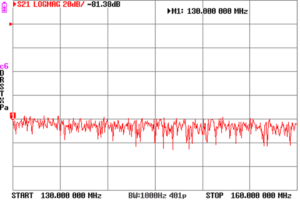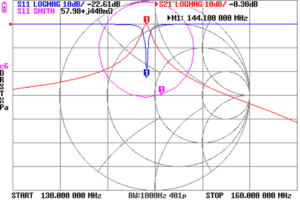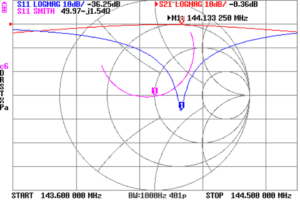This article discusses measurement of a coaxial filter. These are often referred to as “cavity filters”, but strictly speaking, a resonant cavity is different, these are a low loss transmission line section without input and output coupling.
The DUT is a single coaxial resonator configured as a band pass filter with adjustable separate coupling loops. The inside of this nearly quarter wave tube is a coaxial rod grounded at the right had end and almost reaching the left hand end with coupling loops attached to the coax connectors. The rod length is adjustable to tune it, everything is silver plated brass. The adjustable coupling loops allow some adjustment of bandwidth, but narrow bandwidth brings higher loss.
The filter is currently set for its tightest coupling, widest bandwidth, lowest loss.
It was last used for experiments to show that some ham grade receivers commonly used lack sufficient front end selectivity to deliver in the real world, the ‘shielded room’ performance stated in the specifications.
The instrument used here is a NanoVNA-H4 v4.3 and NanoVNA-D firmware NanoVNA.H4.v1.2.33.
It was SOLIT calibrated at the ends of 300mm RG400 patch leads on both ports. It was attached to the DUT with SMA(F)-N(M) adapters.
Let’s assess the NanoVNA s21 noise floor
Above is a plot of the noise in the s21 path, the noise floor is approximately -80dB, so measurements cannot be made with confidence down to about -70dB.
Whilst that noise floor probably permits measuring single stage rejection, especially with notches in duplexer filters, it is probably not sufficient to measure a cascade of two filter sections, much less three (which is a common configuration).
Now the measurement of s11 and s21
Above is a wide sweep from 130-160MHz (note the changed |s21| scale from the previous screenshot.
Above is a narrower sweep over the ~3dB bandwidth. 3dB bandwidth is about 800kHz. ReturnLoss>20dB bandwidth (VSWR<1.2) is less than 100kHz (ReturnLoss=-|s11|.)
What if it had a notch filter as well?
We might expect that a notch would be 30dB to more than 50dB down. That is far enough above the |s21| noise floor to measure, but the notch of a cascade of filter sections will probably dip into the noise.
It might seem sufficient to measure the depth of notch in one stage of a filter, but thorough measurement requires assessment of the notch overall to demonstrate that they all line up on the correct frequency.
So, the often asked question…
Is this NanoVNA suitable for alignment and measuring performance of a typical repeater duplexer?
IMHO, no, it lacks sufficient dynamic range to measure the notch depths typically required.



